Olympus Mons is one of a dozen large volcanoes, many of which are ten to a hundred times taller than their Earthly counterparts. If Martian space tourism takes off in the coming decades, Olympus Mons could become a prime destination for adventure enthusiasts. Olympus may once have been a volcanic island surrounded by an ocean nearly 4 miles (6 km) deep, according to geological evidence found in the high cliffs. Another new study found that the rover discovered polygonal wedges 35 kilometers underground – the first time they have been discovered beneath the planet’s surface. Evidence suggests that the wedges formed between 3.7 and 2.9 billion years ago due to major climate changes in Mars’ past. The Mars Express orbiter has discovered enough water ice buried beneath the Red Planet’s equator to cover the entire planet in a shallow ocean if it melted.
Mysterious geometric shapes beneath the surface of the Red Planet hint at ancient secrets
On May 14, 2021, China became the second country to ever place a rover on the surface of Mars. Named Zhurong after the ancient Chinese god of fire, the rover landed on the Martian Utopian Plain, the largest impact basin on Mars (and, for that matter, in the entire solar system). Over the course of one Earth year, China’s Zhurong rover explored the surface of Mars using ground penetrating radar. Equipped with a ground-penetrating radar system, Zhurong quickly got to work and far exceeded its originally planned three-month mission—it was eventually shut down in May 2022 after spending little more than an Earth year on Mars. During this time, the rover collected invaluable data about what is happening below the surface of Mars, including amazing polygonal shapes located at a depth of 35 meters.
A new study has found that the rover has discovered polygonal wedges 35 kilometers underground – the first time they have been discovered beneath the planet’s surface. Evidence suggests that the wedges formed between 3.7 and 2.9 billion years ago due to major climate changes in Mars’ past. This previously unknown geological structure, and what it reveals about Mars’ past, was detailed in a recent study published in the journal Nature Astronomy, written by scientists from the Institute of Geology and Geophysics of the Chinese Academy of Sciences.
16 polygonal wedges were discovered within a radius of 1.2 kilometers. They estimate that these forms formed during the Late Hesparian to Early Amazonian epochs (yes, there are epochs on Mars too), which occurred approximately 3.7 to 2.9 billion years ago. According to the article, these wedges formed “probably with the cessation of ancient humid environments.”
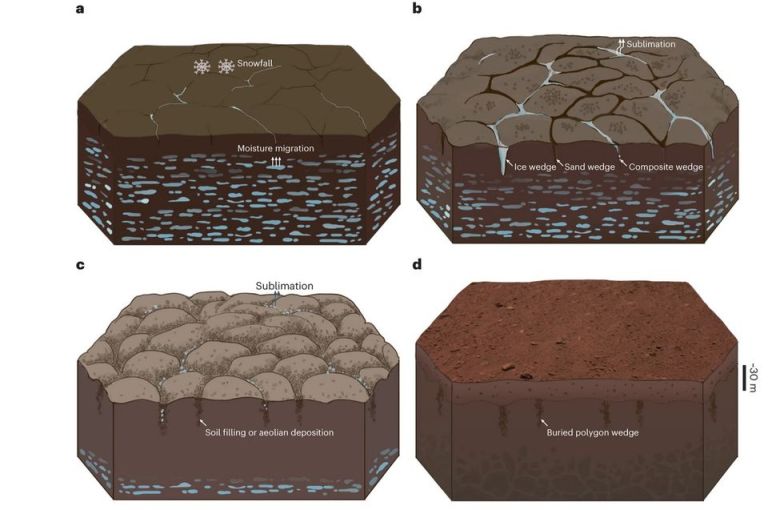
Detailed process of formation of Martian polygonal wedges over billions of years
“The formation mechanism of the buried paleo-polygonal landscape requires a cold environment and may be related to water/ice freeze-thaw processes in the southern Utopian Plain of early Mars,” the paper states. “The discovered buried polygons, which indicate that freezing occurred at low and mid-latitudes, require strong paleoclimatic variability.”
While these polygonal structures on Mars have never been discovered beneath the surface before, they are not a new discovery, as Universe Today explains. For example, NASA spotted them on the surface of the northern lowlands back in 2012, saying at the time that “scientists study the polygonal surface of Mars because the occurrence and physical characteristics of polygons help us understand the recent and past distribution of ice on the shallow surface and provide insight into climate conditions.” .
Researchers are sure of one thing: such formation will require low temperatures. “The possible presence of water and ice required for the freeze-thaw process in the wedges could be the result of cryogenic suction-induced moisture migration from an underground aquifer on Mars, snowfall from the air, or vapor diffusion to deposit pore ice,” the paper states.
Although today’s Mars appears to be a homogeneous, desert-like planet, evidence of a dynamic history can still be found on its surface—and many meters below it.
Sand dunes meet stacked ice at Mars’ north pole
ESA’s Mars Express captured intriguing images near Mars’ north pole, where huge sand dunes meet the many layers of dusty ice that cover the planet’s pole.
The area around Mars’ north pole, known as Planum Boreum, is mesmerizing. The pole itself is covered in layers of fine dust and water ice; they are several kilometers thick and extend over about 1000 km (roughly the width of France).
While much of this material is not visible here, the beginning of Planum Boreum can be seen to the right of the frame, with small folds showing where layers of material begin to accumulate. The land also became sharper and more stepped, as can be seen most clearly in the topographical image of the region below. Areas with the lowest elevation are blue/green and the highest are red/white/brown.

Topography of the northern polar region of Mars. ESA
These layers formed as a mixture of dust, water ice and frost settled on the Martian soil over time. Each layer contains valuable information about the history of Mars, revealing how the planet’s climate has changed over the past few million years.
During the Martian winter, the layers are covered with a thin cap of dry ice (carbon dioxide ice) a couple of meters thick. Every Martian summer, this cap completely disappears into the atmosphere.
The following image was captured by the Mars Express High Resolution Stereo Camera (HRSC). Two steep banks or slopes vertically cut through the frame. They mark the boundary between the aforementioned layered deposits (which extend poleward out of frame, right) and the vast, broad dune fields that cover the lower part of Planum Olympia (left).
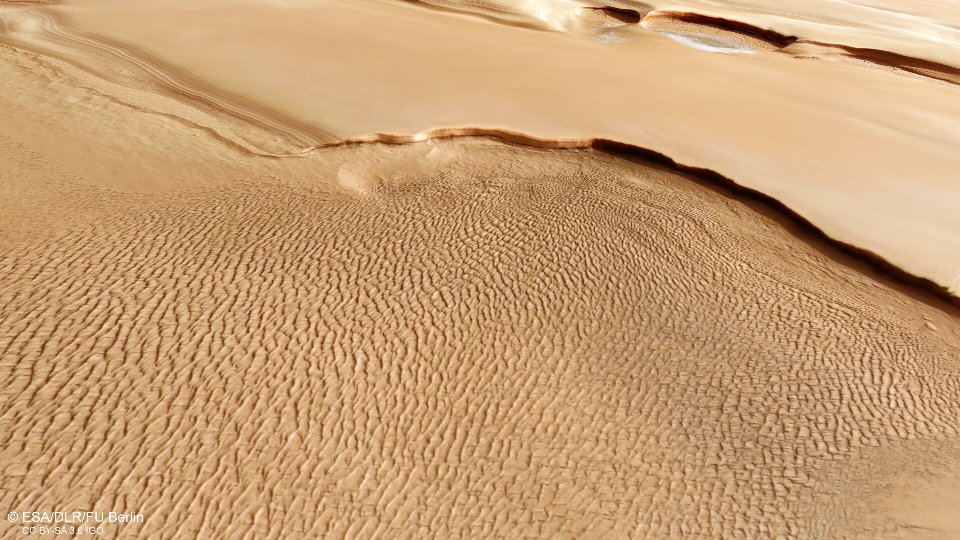
Sand dunes meet folded ice at the north pole of Mars. ESA
The left side of this image is dominated by a vast, elongated band of undulating sand dunes, stretching for more than 150 km in this frame alone. This wrinkled, restless appearance contrasts sharply with the smooth, more pristine terrain visible to the right. This smooth region shows no obvious signs of erosion and has not been impacted by rocks coming from space, an indication that the surface is very young and likely renews itself every year.
Between these two extremes are two semicircular rocks, the larger of which is about 20 km wide. In the curves of these rocks are frost-covered sand dunes. The enormity of the cliffs is clearly visible in the dark shadows they cast on the surface below: their steep ice walls rise up to a kilometer high.
These two rocks are located in the so-called polar trench, formed by the wind that erodes the surface. They appear as undulating ridges in the terrain and are common in the region, creating the characteristic spiral pattern of the polar plateau (most clearly seen in the wider context image of the region below and in other images of Planum Boreum from Mars).
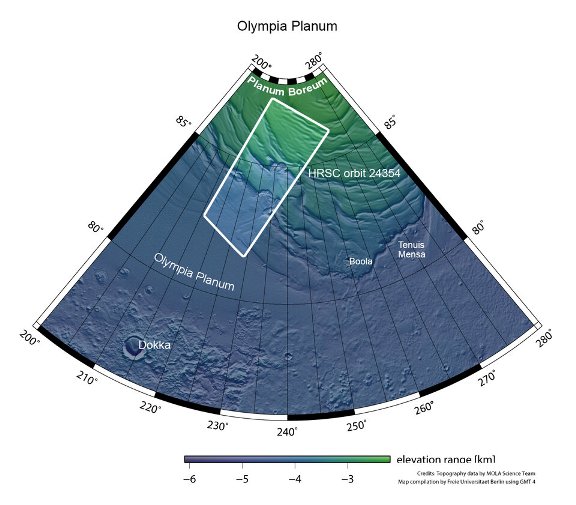
Olympia Planum and Planum Boreum. ESA
Mars Express has been orbiting the Red Planet since 2003. It photographs the surface of Mars, maps its minerals, determines the composition and circulation of its thin atmosphere, explores the subterranean crust, and studies how various phenomena interact in the Martian environment.
The spacecraft’s HRSC has revealed a lot about the diverse surface of Mars over the past 20 years. His images show everything from wind-sculpted ridges and furrows to craters on the slopes of colossal volcanoes and impact craters, tectonic faults, river channels and ancient lava lakes. During its lifetime, the mission was extremely productive, creating a much more complete and accurate understanding of our planetary neighbor than ever before.
Martian dunes
On January 16, 2020, the Mars Reconnaissance Orbiter (MRO) captured this image of two types of sand dunes on Mars: dunes and linear dunes.
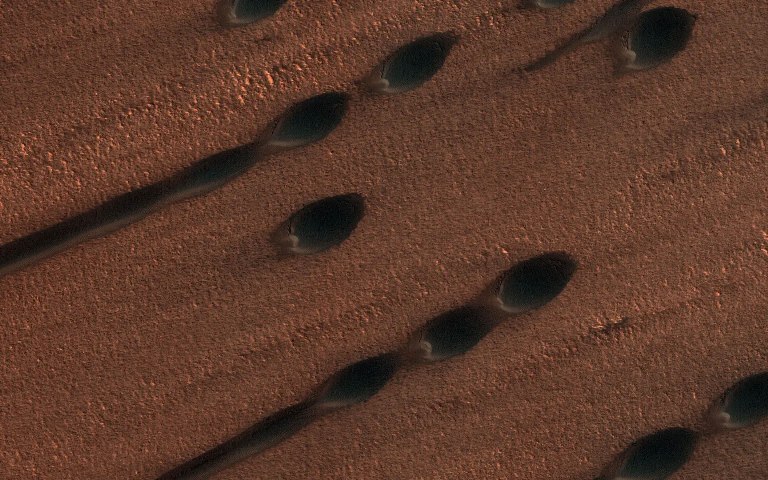
Martian dunes. NASA/JPL-Caltech/University of Arizona
The small points are called sand dunes, and from their shape you can tell that they are located on the leeward side. The dunes on the leeward side are long and linear. Each of these two types of dunes shows the direction of the wind differently: dunes have a steep slope and crescent-shaped “horns” directed against the wind, while linear dunes are elongated along the main direction of the wind. However, linear dunes usually indicate at least two prevailing winds that stretch the sand in a middle direction.
Barchans and linear dunes are not only a Martian phenomenon, we can also see them on Earth. Astronauts aboard the International Space Station photographed the events in Brazil and Saudi Arabia.
A giant volcano has been hiding in plain sight for decades in one of Mars’ most iconic regions
A new study has revealed a giant volcano and possibly a layer of buried glacial ice. The location for this groundbreaking announcement is in the eastern part of the Tharsis volcanic province on Mars, near the planet’s equator. Due to its blurriness and inaccessibility, the site has been missed since Mariner 9 collected images of the site in 1971.
The discovery was reported during the 55th Lunar and Planetary Sciences Conference, according to a statement from the SETI Institute. The study was conducted using data from NASA’s Mariner 9, Viking Orbiter 1 and 2, Mars Global Surveyor, Mars Odyssey and Mars Reconnaissance Orbiter missions, and the European Space Agency’s Mars Express mission.
The giant volcano has been hiding in plain sight for decades in one of the most iconic regions of Mars, on the border between the highly fractured labyrinth Noctis Labyrinth (Labyrinth of Night) and the vast canyon system of Valles Marineris (Valles Marineris). In the area where the newly recorded volcano is located, there are other famous giant volcanoes: Mons Ascraeus, Mons Pavonis and Mons Arsia.
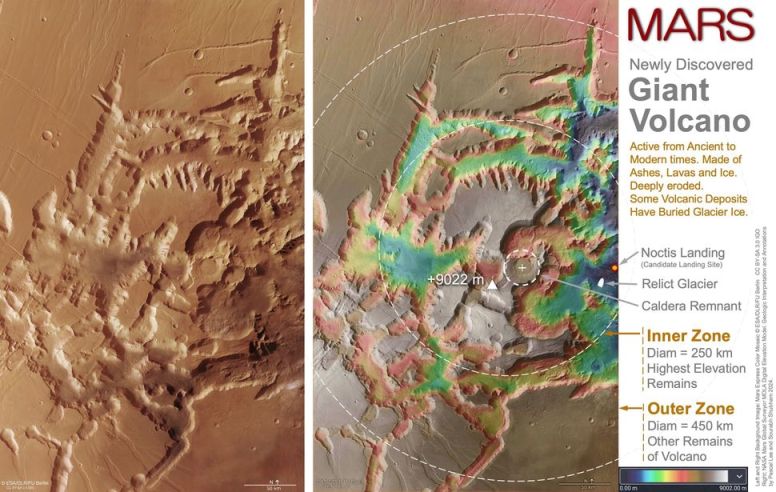
Detailed analysis of the region’s altimetry using NASA’s Mars Global Surveyor (MGS) Mars Orbiter Laser Altimeter (MOLA) data combined with high-resolution imaging data from the High Resolution Imaging Science Experiment (HiRISE) from the Mars Reconnaissance Orbiter ( MRO) NASA and context. Imager (CTX) and the European Space Agency’s (HRSC) Mars Express High Resolution Stereo Camera (MEX) have discovered Noctis Volcano. In addition to the volcano’s summit, the remains of the caldera, and the inner and outer zones, the topographic map on the right shows a “relic glacier” discovered in 2023, and Noctis’ Landing, a potential landing site for future robotic and human exploration. Mars Express color mosaic HRSC © ESA/DLR/FU Berlin CC BY-SA 3.0 IGO; right: background image: same as left; NASA digital elevation model MGS MOLA. Geological interpretation and annotation by Pascal Lee and Sourabh Shubham 2024
Although the newly discovered volcano is more eroded and less tall than these other volcanic counterparts, it rivals the others in diameter: about 280 miles (450 kilometers) and approximately 29,600 feet (9,022 meters) in height.
“Its discovery points to an exciting new location for the search for life and a potential site for future exploration by robots and humans,” the SETI Institute said in a statement.
Lead author of the study is Pascal Lee, a planetary scientist at the SETI Institute and the Mars Institute, based at NASA’s Ames Research Center. Lee explains.
The volcano’s enormous size and complex history of change indicate that it has been active for a very long time. In addition, in its southeastern part there are thin recent volcanic deposits, under which glacial ice is likely still present.
“This region of Mars is known to have a wide variety of hydrated minerals, spanning a long period of Martian history,” explains Sourabh Shubham, a graduate student in the Department of Geology at the University of Maryland and co-author of the study.

Topographic map showing the iconic location of Noctis Volcano between the major volcanic provinces and canyons of Mars. Digital elevation model of NASA’s Mars Global Surveyor (MGS) Mars Orbital Laser Altimeter (MOLA). Geological interpretation and annotation by Pascal Lee and Sourabh Shubham, 2024.
“It has long been assumed that these minerals have a volcanic environment. So it is not surprising that there is a volcano here,” Shubham added. “In some ways, this big volcano is the long-awaited ‘smoking gun.'”
Volcano Noctis does not have the traditional conical shape of a typical volcano because a long history of deep fissures and erosion has altered it. However, upon closer inspection, key features that indicate a volcano can be recognized. Within the “inner zone” delineating the highest remnants of the volcano, an arc of high mountains marks the central summit area, culminating at +9,022 m (29,600 ft). The remaining portions of the volcano’s slopes extend down in different directions to the outer edge of the “outer zone”, a distance of 225 km (140 mi) from the summit. The caldera remnant – the remains of a collapsed volcanic crater that once sat in a lava lake – can be seen near the center of the structure.
Lava flows, pyroclastic deposits (composed of volcanic solids such as ash, ash, pumice, and tephra), and hydrothermal mineral deposits occur in several areas around the perimeter of the volcanic structure. The map also shows the field of rootless cones and the possible extent of the shallow buried glacial ice reported in this study compared to the “relict glacier” discovered in 2023.
While it is clear that the volcano has been active for a long time and began to form early in Mars’ history, exactly how early is unknown. Likewise, although eruptions have been observed even in “modern times”, geologically speaking, it is unknown whether the object is still volcanically active and whether it could erupt again. If it had been active for a long time, could the combination of sustained heat and ice water have allowed the site to harbor life?

The newly discovered giant volcano on Mars is located south of the planet’s equator, in the Eastern Labyrinth of Noctis, west of Valles Marineris, the planet’s vast canyon system. The volcano is located on the eastern edge of a broad regional topographic hill called Tharsis, where three other famous giant volcanoes are located: Ascraeus Mons, Pavonis Mons and Arsia Mons. Background image: NASA/USGS Mars Globe. Geological interpretation and annotation by Pascal Lee and Sourabh Shubham, 2024.
It is a combination of factors that makes the site of the Noctis volcano exceptionally interesting. It is an ancient and long-lived volcano, so deeply eroded that it can be walked, driven or flown through to explore, sample and date various parts of its interior to study the evolution of Mars over time. The long history of heat interacting with water and ice makes it an ideal location for astrobiology and the search for signs of life.
Finally, because glacial ice likely still persists near the surface in the relatively warm equatorial region of Mars, “this looks like a very attractive location for robotic and human exploration,” Lee said in the SETI statement.
The possible presence of glacial ice at shallow depths near the equator means humans could potentially explore the cooler part of the planet while still being able to extract water for hydration and rocket fuel production. This fuel can be produced on Mars by splitting water into hydrogen and oxygen.
The famous Olympus: the largest volcano in the solar system
Olympus Mons is a giant volcano on Mars, three times taller than Everest and as wide as France. Olympus Mons Mars is the largest volcano in the Solar System. Massive Martian mountains rise above the surrounding plains of the Red Planet and may be biding their time until the next eruption.
Olympus Mons, located in the Tharsis-Montes region near the Martian equator, is one of a dozen large volcanoes, many of which are ten to one hundred times taller than their Earthly counterparts. Mount Olympus is the tallest of them all, rising 16 miles (25 kilometers) above the surrounding plains and spanning 374 miles (601 kilometers)—about the same length as the state of Arizona.
By comparison, Mauna Loa in Hawaii, the tallest volcano on Earth, rises 6.3 miles (10 km) above the sea floor (but its summit is only 2.6 miles above sea level). The volume of Olympus Mons is about a hundred times the volume of Mauna Loa, and the entire chain of Hawaiian islands (from Kauai to Hawaii) on which it is located could fit inside its Martian counterpart.
Because there is no surface water on Mars, determining the altitude there is not as easy as on Earth. But scientists have determined the effective “sea level” for Mars, known as the areoid, which is an imaginary sphere having the average equatorial radius of the planet. This turns out to be slightly higher than the plain surrounding Mount Olympus, and relative to the areoid the height of the mountain is only 13 miles (21 km) – but it is still a record size.
Despite this, the fact that it is so wide means that it does not look like a typical mountain on Earth. If you stood on it, it would just look like a gently sloping plain.
Mount Olympus rises three times higher than Earth’s tallest mountain, Everest, whose summit is 5.5 miles (8.8 km) above sea level. Olympus is a shield volcano. Instead of violently spewing molten material, shield volcanoes are created by lava flowing slowly down their sides. As a result, the mountain has a low, squat appearance with an average slope of only 5 percent.
Compared to the Martian terrain in general, there are not many impact craters on the surface of Olympus. This indicates that the topmost layer of lava is relatively young: the last eruption occurred only 25 million years ago. This could mean that the volcano is still active and may erupt again in the future.
Six collapsed craters, known as calderas, stack on top of each other to form a 53-mile (85 km) wide depression at the top. As the magma chambers beneath the calderas emptied of lava, most likely during an eruption, the chambers collapsed, no longer able to support the weight of the earth above. A cliff or escarpment surrounds the outer edge of the volcano, reaching a height of 6 miles (10 km) above the surrounding area. (The cliff alone is about the same height as Mauna Loa.) A wide depression surrounds the volcano’s base as its enormous weight presses down on the crust.

Mount Olympus is the largest volcano in the solar system. ESA/DLR/FU Berlin/Mars Express/Andrea Luck CC BY 2.0
Mount Olympus is still a relatively young volcano. Although it took billions of years to form, some regions of the mountain may be only a few million years old, which is a relatively young age in the lifetime of the solar system. Thus, Mount Olympus may still remain an active volcano with eruption potential.
The solar system’s tallest volcano may also contain rock glaciers—rock fragments frozen in ice. Deposition of snow and ice above the base of the shield could lead to the formation of such glaciers. Water ice, isolated from surface dust, can exist near the summit of a volcano. The tops of these glaciers may have ridges, grooves and lobes, be covered with rocks and boulders, and may be as young as four million years old.
Why did such a huge volcano form on Mars and not on Earth? Scientists believe the Red Planet’s lower surface gravity, combined with a higher eruption rate, allowed lava to accumulate higher on Mars.
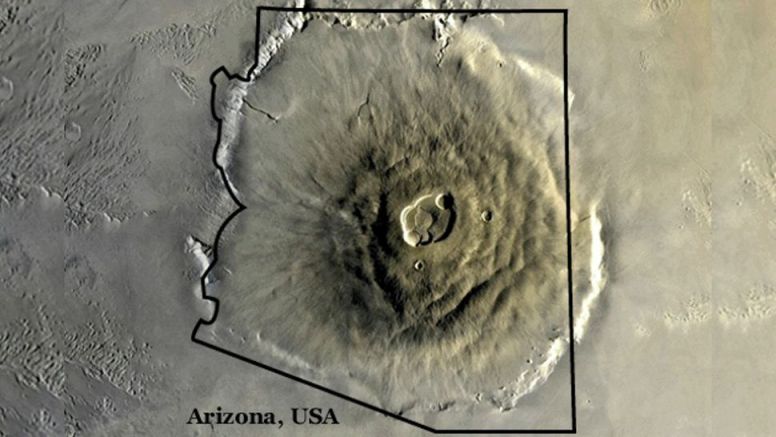
The black outline of Arizona in this image of Mount Olympus shows similar surface areas. NASA
The presence and absence of tectonic plates could also play an important role in different types of volcanoes. Lava hot spots beneath the crust remain in the same location on both planets. However, on Earth, crustal movement prevents the sustainable accumulation of lava. For example, the Hawaiian Islands were formed by plate drift over a hot spot. Each eruption created a small island in a different location.
But on Mars, plate motion is very limited. Both the hot spot and the crust remain motionless. When lava flows to the surface, it continues to accumulate in one place. Instead of a chain of volcanic islands, large volcanoes such as Mount Olympus are formed. In fact, the three other major volcanoes near Mount Olympus are equally gigantic; if only one of the four volcanoes in this region existed, it would be the tallest object in the solar system.
In addition to the lack of plate movement, Olympus’s growth was facilitated by its long existence. Although we don’t currently have rovers exploring mountains, planetary scientists have been able to explore volcanoes using rocks from Earth. By studying six nakhlite meteorites from Mars, previously recognized as volcanic, scientists have confirmed the long existence of Martian volcanoes.
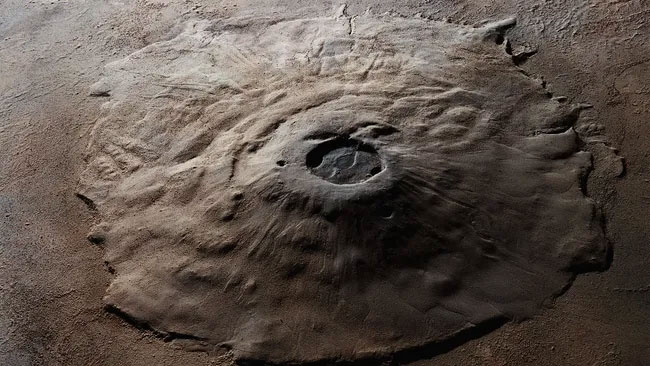
View from orbit of the Martian volcano Olympus. Getty Images
“Nakhlites were formed by at least four eruptions over 90 million years,” Benjamin Cohen, a planetary scientist at the University of Glasgow in Scotland, said in a statement. “That’s a very long lifespan for a volcano, much longer than the lifespan of Earth’s volcanoes, which are typically active for only a few million years.”
The meteorites were thrown into space when a massive rock crashed into the planet 11 million years ago. “And this only scratched the surface of the volcano, since only a very small amount of rock would have been ejected from the impact crater – so the volcano must have been active for much longer,” Cohen said.
Another group of 11 Martian meteorites showed that the volcanoes had been active for even longer. Ten of them were only 500 million years old, and the 11th, NWA 7635, was 2.4 billion years old.
“This means that for 2 billion years, there was some sort of persistent plume of magma at one location on the surface of Mars,” researcher Mark Caffey, a professor of physics and astronomy at Purdue University in Indiana, said in a statement. “We don’t have anything like this on Earth, where something is stable for 2 billion years in a particular location.”

The lava is believed to have flowed from this large volcanic vent in the Tharsis region of Mars. NASA/JPL-Caltech/University of Arizona
The volcanoes at Tharsis Montes are so large that they rise above the seasonal Martian dust storms. Italian astronomer Giovanni Schiaparelli, who intensively studied the surface of Mars in the late 19th century, observed the huge objects from Earth using an 8-inch (22 cm) telescope. When NASA’s Mariner 9 arrived at the Red Planet in 1971, it was able to discern the peaks of volcanoes above the storms.
The high altitude of Mount Olympus makes it difficult to parachute into the thin atmosphere, and the presence of loose dust can cause problems with maneuvering Mars rovers. However, if Martian space tourism takes off in the coming decades, Mount Olympus could become a prime destination for adventure seekers. In 2021, a group of students from the Royal Institute of Technology in Stockholm, Sweden, prepared a mission proposal that they believe could be feasible by 2042. The rover will take a group of three to the top of a giant volcano, and then two of them will walk the final section.
Alternatively, a company called 4th Planet Logistics, which describes itself as “founded for the purpose of designing, constructing and evaluating human habitat structures and associated supporting components for use on the Moon, Mars and beyond, is seeking to create a virtual-to-real route climbing a huge mountain.
“I would like to extend a personal invitation to participate in our efforts to create a route to the summit of Mount Olympus,” 4th Planet Logistics founder and director Michael Chalmer Dunn said in a company blog post. This means that while you can’t physically climb the huge volcano, you can at least check it out visually. Some scientists used the high-resolution stereo camera on Europe’s Mars Express orbiter to create a mosaic and model of the volcano’s terrain.
Landslides on Mars suggest that water once surrounded Mount Olympus, the tallest volcano in the solar system.
New evidence suggests that Olympus Mons was once bordered by the Martian ocean, which played a major role in the formation of the planet’s iconic stripes. The case for Martian volcanoes rising above ancient lost oceans is growing stronger.
Researchers analyzing images of Olympus Mons on Mars, the tallest volcano in our solar system, say the wrinkled patch of land near the northern part of the mountain was likely formed when scalding hot lava flowed from the summit millions of years ago. It is believed that this lava collided with ice and water at the base of the mountain, causing landslides. At least some of these landslides must have extended about 621 miles (1,000 km) from the volcano and shriveled, hardening over centuries, scientists say.

A view of the boulder-rich surface deposited by the previous tsunami. They were then destroyed by channels formed when the tsunami water returned to ocean height (the white arrow shows the direction of return flow). Yellow stripes – 10 meters. NASA/Alexis Rodriguez
Although such striped formations on Mars have long been studied, the role of water in their formation remains an open question. The new findings add to the prevailing theory that liquid water once flowed freely across the Red Planet, which is now a cold, desert world save for remnants of ice largely trapped inside its poles.
The crumpled piece of land depicted in the new images is known as Lycus Sulci (Sulci is a geological term; Latin for parallel grooves). It was photographed in January this year by the European Space Agency’s Mars Express orbiter, which celebrated two decades of orbiting Mars in search of signs of underground water.

Licus Sulci. ESA/DLR/FU Berlin
These new discoveries come on the heels of similar geological evidence discovered regarding the giant rocks surrounding Mount Olympus. Researchers believe these rocks, or escarpments as they are called, mark an ancient coastline, within which lies a large depression where liquid water once circulated. The latest findings support this idea, suggesting that the lower part of the mountain collapsed when the ice and water at its base became unstable after colliding with lava that emanated from within.
“This collapse occurred in the form of huge rockfalls and landslides that slid down and spread widely across the surrounding plains,” the researchers wrote in a statement.
Lycus Sulci, depicted in the new images, extends 621 miles (1,000 km) from Mount Olympus and stops near the Yelwa crater, a 4.9-mile (8 km) long Martian bowl named after a city in Nigeria. The grooves marking lava flows near Yelwa Crater show “how far destructive landslides traveled from the volcano’s flanks before settling,” the researchers said in the same statement.
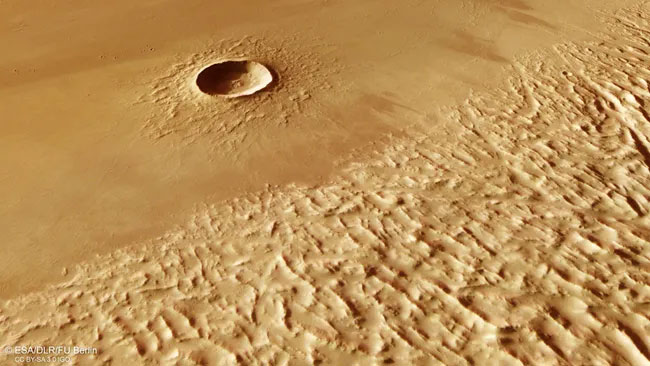
This view of Lycus Sulci and the Yelva crater on Mars was created using a digital terrain model and the nadir and color channels of the high-resolution stereo camera on ESA’s Mars Express. The background features the Jelva crater, while the rugged terrain of Lycus Sulci dominates the foreground. These objects are located on the edge of the “halo” of Mars’ largest volcano, Olympus Mons. ESA/DLR/FU Berlin
Although a tantalizing possibility, the new results do not allow us to conclude whether the Licus Sulci region was predisposed to life on Mars. On Earth, however, a first-of-its-kind study conducted in 2019 found that “lava crickets” in Hawaii are able to thrive in the scorching, unforgiving heat of lava that follows volcanic eruptions.
Scientists believe that any living organisms that may have thrived on the once watery Mars died along with the oceans. Few suggest that single-celled organisms may have been able to hibernate deep beneath the planet’s ice caps, although whether they exist today is anyone’s guess.
Water ice buried at Mars’ equator is more than 2 miles (3.5 km) thick
The Mars Express orbiter has discovered enough water ice buried beneath the Red Planet’s equator to cover the entire planet in a shallow ocean if it melted. A European Space Agency (ESA) probe has found enough water to cover Mars in an ocean 4.9 to 8.9 feet (1.5 to 2.7 meters) deep, buried in dusty ice beneath the planet’s equator.
The discovery was made by ESA’s Mars Express mission, a veteran spacecraft that has been conducting science around Mars for 20 years. While this is not the first time evidence of ice has been found near the Red Planet’s equator, this new discovery is by far the largest amount of water ice found there so far and appears to be in line with previous discoveries of frozen water on Mars.
“It’s surprising that the radar signals match what we would expect to see from layered ice, and are similar to the signals we see from the polar caps of Mars, which we know are very ice-rich,” said lead researcher Thomas Watters of the Smithsonian Institution. in the US in a statement from ESA.
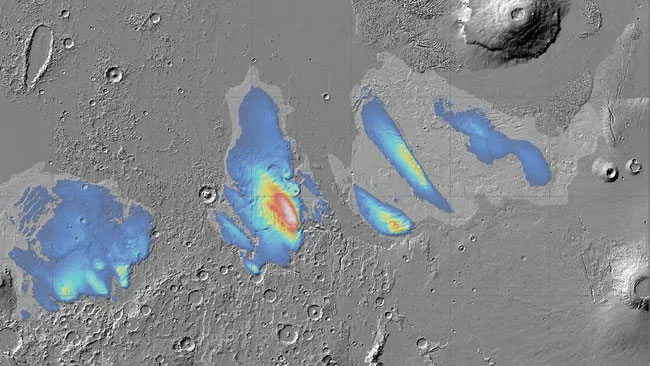
This map shows the approximate amount of ice in the mounds that make up the Medusa Fossa Formation (MFF), consisting of a series of wind-blown deposits hundreds of kilometers across and several kilometers high, indicating that ice-rich sediments occur at elevations up to 3000 meters. Planetary Science Institute/Smithsonian Institution
The deposits are thick, extending 3.7 km (2.3) miles underground, and covered with a crust of hardened ash and dry dust hundreds of meters thick. The ice is not a clean block, but is heavily contaminated with dust. While its presence near the equator makes it more accessible for future crewed missions, its location at such depths means that access to water ice will be difficult.
About 15 years ago, Mars Express discovered deposits beneath a geological formation called the Medusa Fossa Formation (MFF), but scientists weren’t sure what the deposits were made of. The geography of Mars is divided into northern highlands and southern lowlands, and a huge 5000 km long permafrost is located near the boundary between them.
The permafrost itself is believed to have formed over the last 3 billion years from lava flows and was covered by volcanic ash during a long-ago era when Mars was volcanically active. Today, the IMF is covered in piles of dust several kilometers high—in fact, it is the most abundant source of dust on the entire planet, for the giant dust storms that can seasonally engulf Mars. Were the deposits simply dust, perhaps filling a deep valley?
New observations of MARSIS, the underground radar aboard Mars Express, have now provided an answer – and it’s not dust.
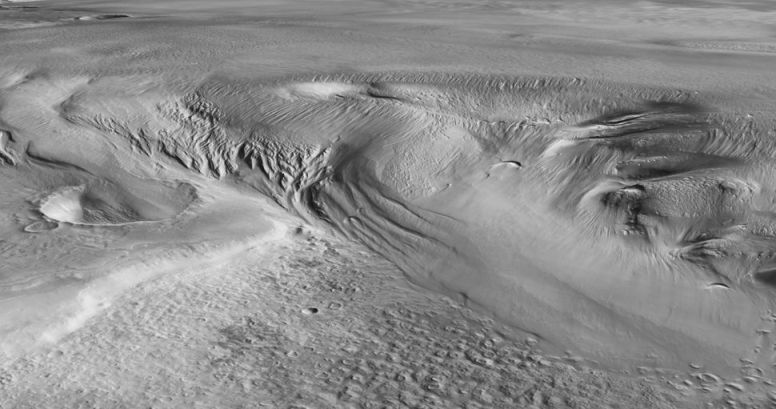
Eumenides Dorsum, part of the Martian Medusae Fossae Formation (MFF). The permafrost consists of a series of wind-formed deposits hundreds of kilometers across and several kilometers high. These deposits, located at the boundary between the highlands and lowlands of Mars, are perhaps the largest source of dust on Mars and one of the most extensive deposits on the planet. Caltech/JPL Global CTX Mosaic of Mars/Smithsonian Institution
“Given how deep it is, if the MFF were just a giant pile of dust, we would expect it to compact under its own weight,” Andrea Cicchetti of the National Institute of Astrophysics in Italy said in a press statement. “This would create something much denser than what we actually see with MARSIS.”
Instead, the sediments are low density and fairly transparent to the MARSIS radar, which is how you would expect water ice to appear in the data.
A more pressing question is how water ice ended up buried at the equator. Subsurface ice on Mars has been found in large quantities before, for example, in 2008, NASA’s Phoenix mission excavated ice just below the dusty surface on the lander’s polar site.
Just recently, ESA’s Trace Gas Orbiter discovered hydrogen from water ice just beneath the surface of Candor Chaos, which is a segment of a huge rip in the surface of Mars that we call Vallis Marineris. Additionally, the remains of ancient glaciers, called relic glaciers, have been discovered in the Eastern Labyrinth of Noctis, which lies just 7.3 degrees south of the equator.
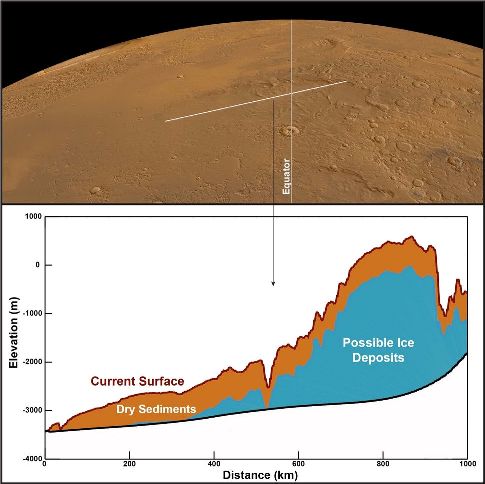
The white line on the surface of Mars (above) shows an area of land scanned by MARSIS. The graph below shows the shape of the land and the structure of the subsurface, with a layer of dry sediment (likely dust or volcanic ash) in brown and a layer of suspected ice-rich sediment in blue. The graph shows that ice deposits are thousands of meters high and hundreds of kilometers wide. CReSIS/KU/Smithsonian Institution
The presence of underground water ice at low and equatorial latitudes hints at how very different Mars’ climate was in the distant past. The existence of ice could be the result of Mars’s wandering axis. It is believed that throughout the history of the Red Planet, the axial tilt of the planet’s poles has changed quite chaotically. Currently, the poles of Mars are tilted to the ecliptic by 25 degrees (compared to Earth, which is tilted at 23 degrees), but in the past this angle could vary from a small angle, such as 10 degrees, to an angle as extreme as 60 degrees.
During periods of high tilt, when the poles point closer to the Sun than to the equator, water ice can form in large quantities on the surface of the equator. This ice could then be buried under ash and dust and remain covered to this day. The tilt change may also explain the 400,000-year-old features discovered on Mars by the Chinese Zhurong rover, as well as the existence of gullies formed by liquid water where such water should not exist.
The new discovery is described in an article published in the journal Geophysical Research Letters.
Thousands of strange white rocks found on Mars
Mars’ rusty red surface may have given it its famed “Red Planet” status, but thousands of white rocks are strangely scattered across the Martian soil. NASA’s Perseverance rover, a robotic geologist that has been exploring Jezero Crater since early 2021, baffled scientists when it provided images of more than 4,000 light-colored, pebble-sized rocks scattered across the crater’s floor.
“These are very unusual rocks, and we’re trying to understand what’s going on,” Candice Bedford, a planetary scientist at Purdue University in Indiana and a member of the Mars 2020 science team, said at the Lunar and Planetary Science Conference. The announcement comes as NASA completes an architectural analysis of returning Martian rocks to Earth as part of the agency’s ambitious Mars Sample Return (MSR) program.
The white rocks pictured are what scientists call “floating”, meaning they have been removed and transported from their original habitat; some are smooth and pitted, while others are an amalgamation of several layers. Initial analysis by Perseverance’s onboard instruments showed that the rocks were dehydrated not only in their water content, but also in other minerals, including iron, magnesium, calcium and sodium.
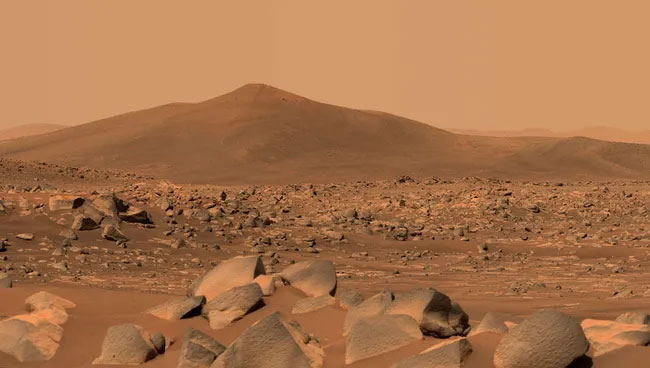
NASA’s Perseverance rover used its dual Mastcam-Z cameras to take this image of Santa Cruz, a hill in Jezero Crater, on April 29, 2021. NASA/JPL-Caltech/ASU/MSSS
The team is particularly interested in the origins of these unusual rocks, as their sources could reveal clues about the Red Planet’s past, including when exactly water flooded the Jezero Crater, which we see today as an arid patch of land. According to Bedford, the dehydrated nature of the rocks suggests they were heated and metamorphosed either by lava flows or asteroid impacts elsewhere on Mars and then dropped to the crater floor. Whatever the specific process, she and her team suspect that, based on the geological history of Jezero Crater, it must have occurred relatively recently.
The Perseverance rover, which has traveled more than 15 miles (24.8 kilometers) since its arrival on Mars, celebrated 1,000 days of science in December 2023, which also marked the official end of the mission for which it was originally intended. So far, it has filled 26 of 43 sample tubes for Martian rock, mission team members told LPSC. “There are countless grains in each sample that we could potentially study forever,” said Benjamin Weiss, a professor of planetary sciences at MIT and a member of the Mars 2020 team.
However, all these mysterious rocks aren’t the only reason scientists are racing to get Perseverance to the crater’s edge and perhaps beyond. They believe there is a unique geology there that has not yet been seen on the crater floor. This includes rocks from before Jezero, which may contain records of the formation of Mars’ crust and early climate. It may even contain evidence of biosignatures.
The 24th Martian sample collected by NASA’s Mars Perseverance rover is “Comet Geyser,” a sample taken from the Jezero Crater region, which is particularly rich in carbonate, a mineral associated with habitability.
“Scientists are now marking many interesting sampling sites and mapping the edge itself in more detail,” said Lisa Mayhew, a research scientist at the University of Colorado Boulder. Of great interest to scientists is an area adjacent to the Jezero Crater called Nili Planum, whose rocks they believe may have formed under warm conditions at a time when life was likely to evolve – if it ever existed on the now barren world. Sampling such rocks will add enormous scientific value to the cache that already exists on Perseverance.
However, this scientific value can only be fully realized once these stones are returned to Earth. Questions remain about the NASA-led MSR program, including when and how the agency plans to return collected samples to Earth. Last October, NASA commissioned a response team (MIRT) to evaluate alternative approaches to MSR after an independent review board (IRB) found that the current architecture would result in cost and schedule overruns.
The Gediz Valley channel was carved by an ancient river
NASA’s Curiosity rover has begun exploring a new region of Mars that may reveal more about when liquid water disappeared once and for all from the Red Planet’s surface. Billions of years ago, Mars was much wetter and likely warmer than it is today. Curiosity will take a new look at this more Earth-like past as it explores the Gediz Valley Channel, a winding, snake-like structure that appears to have been carved by an ancient river.
This possibility has intrigued scientists. The rover team is looking for evidence to show how the channel was cut into the underlying rock. The sides of the formation are so steep that the team doesn’t think the channel was formed by wind. However, debris flows (fast, wet landslides) or rivers carrying rocks and sediment could have enough energy to cut into the bedrock. Once the channel was formed, it was filled with boulders and other debris. Scientists also want to know whether this material was transported by mudflows or dry avalanches.
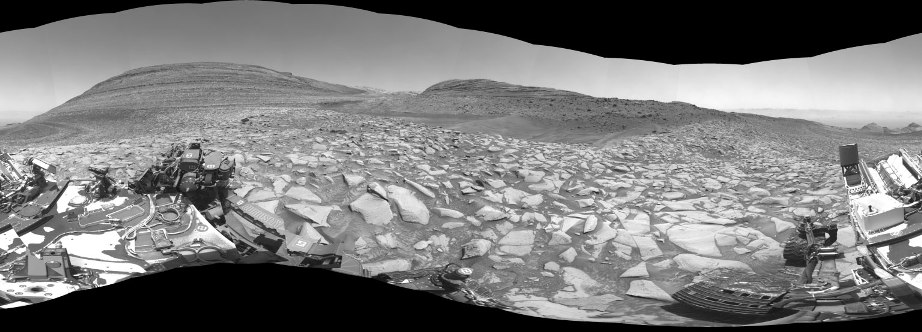
After arriving at the Gediz Valley Channel, NASA’s Curiosity rover captured this 360-degree panorama on February 3 using one of its black-and-white navigation cameras. This formation has intrigued scientists for what it can tell them about the history of water. on the Red Planet. NASA/JPL-Caltech
Since 2014, Curiosity has been climbing to the foothills of Mount Sharp, which lies 3 miles (5 kilometers) above the floor of Gale Crater. The layers in this lower part of the mountain formed over millions of years amid a changing Martian climate, giving scientists the opportunity to study how the presence of water and the chemical ingredients necessary for life changed over time.
For example, at the bottom of these foothills was a layer rich in clay minerals, where a lot of water once interacted with the rocks. The rover is now exploring a layer rich in sulfates, salty minerals that are often formed when water evaporates. It will take months to fully study the channel, and what scientists learn could revise the timing of the mountain’s formation.

The steep path NASA’s Curiosity rover took to reach the Gediz Valley Channel is highlighted in yellow in this visualization created from orbital data. Bottom right is the point where the rover turned to get a closer look at the ridge created long ago by debris flows from the summit of Mount Sharp. NASA/JPL-Caltech/UC Berkeley
As the sedimentary layers of lower Mount Sharp were deposited by wind and water, erosion eroded them, exposing the layers visible today. Only after these long processes, as well as periods of severe drought, during which the surface of Mount Sharp was a sandy desert, could the Gediz Valley channel be formed. Scientists believe the boulders and other debris that subsequently filled the channel came from a mountaintop that Curiosity would never reach, giving the team an idea of what types of material might be there.
“If a channel or debris pile was formed from liquid water, that’s really interesting. This would mean that quite late in Mount Sharp’s history – after a long dry period – water returned, and to a significant extent,” said Curiosity project scientist Ashwin Vasavada of NASA’s Jet Propulsion Laboratory in Southern California.
This explanation fits with one of the most surprising discoveries Curiosity made during its ascent of Mount Sharp: The water seemed to come and go in stages, rather than disappearing gradually as the planet got drier. These cycles can be seen in mud cracks, in shallow salt lakes, and just below the channel in catastrophic mudflows that accumulated to form the vast ridge of the Gediz Valley.
Last year, Curiosity made a difficult climb to study a ridge that cuts across the slopes of Mount Sharp and appears to emerge from the end of the channel, suggesting the two are part of the same geological system.
360-degree video to see the Gediz Vallis Channel from the perspective of NASA’s Curiosity rover. NASA/JPL-Caltech
Curiosity documented the channel with a 360-degree black-and-white panorama captured by the rover’s left navigation camera. The image, taken on February 3 (the 4086th Martian day or sol of the mission), shows dark sand filling one side of the channel and a pile of debris rising just beyond the sand. In the opposite direction is the steep slope that Curiosity climbed to reach this area.
The rover takes such panoramas with its navigation cameras at the end of each trip. Now the science team is relying even more heavily on navigation cameras, while engineers are trying to solve the problem that limits the use of a single thermal imager, the color mast camera, or Mastcam. Curiosity was built by JPL, which is operated by the California Institute of Technology in Pasadena, California. JPL is leading the mission on behalf of NASA’s Science Mission Directorate in Washington.
An asteroid crashed into Mars 2.3 million years ago, scattering debris across the planet.
More than two million years ago, a giant asteroid crashed into Mars, leaving one massive crater and about two billion smaller individual craters on the surface. These secondary craters appear at a distance of 1,000 miles (1,800 kilometers), making this asteroid event one of the largest impacts observed on the Red Planet in relatively recent history. Asteroids massive enough to cause such widespread destruction are estimated to impact Mars only once every 3 million years.
The impact occurred on the equator of Mars in a region that humanity called Elysium Planitia; it left behind the main crater of Corinto, 8.6 miles (13.9 km) wide and 0.62 miles (1 km) deep. On the other hand, the secondary impact craters range in size from 656 feet (200 meters) to 0.8 miles (1.3 kilometers) in diameter and extend outward in a large “ray system,” according to the scientists behind the findings.
Despite being 2.3 million years old, the crater and its minor parts – some of which are carved into lava flows originating from the summit of the extinct Martian volcano Elysium Mons – are considered by the team to be extremely young.
“Corinto Crater is a new impact crater in Elysium Planitia that has formed one of the most extensive systems of heat rays and secondary craters on Mars, extending approximately 1,243 miles (2,000 km) to the south and spanning an arc of nearly 180° on Mars,” wrote team in the related study.

Image of craters formed by the Corinto Impact 2.3 million years ago. NASA, University of Arizona
The authors explained how they used thermal and visible imaging data collected by NASA’s Mars Reconnaissance Orbiter to describe the crater and the mantle of fragments, or “ejecta,” ejected into the Martian atmosphere by the impact. An ejecta refers to any material that is “thrown” out of the crater as a result of some kind of impact. In this case, the ejecta are pieces of Mars ejected from the giant cavity of the main crater, formed as a result of the crash of an asteroid.
This data, collected by the spacecraft’s High Resolution Imaging Experiment (HiRISE) instruments and the Context Camera (CTX), was fed to a machine learning program that separated the craters caused by this impact from other Martian craters caused by asteroid impacts. This information was then used to estimate the age of the impact and the total number of secondary craters created by the original impact.
By measuring the distribution of secondary craters extending from Corinto, the team found the greatest concentration south and southwest of the main impact crater. the atmosphere of the Red Planet at an angle of about 30–45 degrees from the north or northeast.
The farthest secondary craters discovered by researchers showed that some of the impact’s ejecta were released as far as 1,150 miles (1,850 km). This is approximately four times the length of the Grand Canyon.
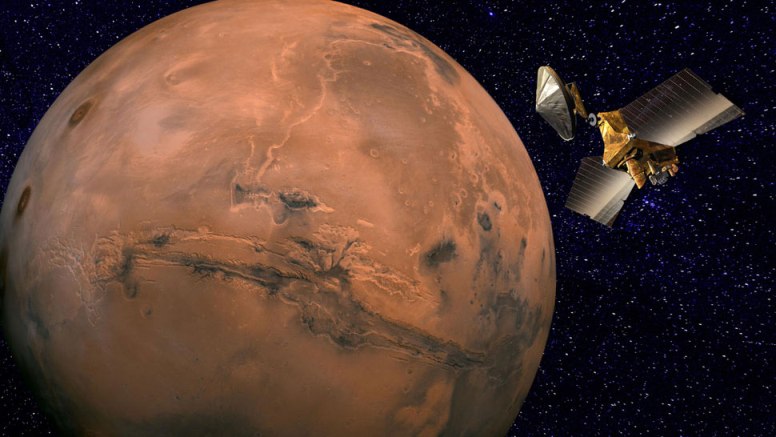
The illustration shows the Mars Reconnaissance Orbiter collecting data in situ around the Red Planet. Robert Lee/NASA
However, secondary craters differed not only in distance from the main impact zone and in size. The team behind the discoveries also classified them by shape. Some were round and semi-circular, while others appeared “flattened round” or “elliptical”.
The researchers determined that the shape or “morphology” of secondary craters is related to the speed at which the fragments that formed them were ejected, the size of those fragments, and the surface composition of the Martian region in which they fell. Near Corinto, secondary craters took on the shape of semicircles, and elliptical craters were found further from the main impact zone.
“The large number of secondary craters formed by Corinto is consistent with most of the ejected material being durable basalt,” the team wrote.
Basalts are volcanic rocks formed by the rapid cooling of lava rich in magnesium and iron, so the fragments likely represent lava previously erupted from the volcano that was hit by the asteroid.
The composition of some of the ejecta ejected from the surface of Mars by an asteroid impact indicates that the space rock fell on water or ice. This is also evidenced by the “pits” scattered along the bottom of the Corinto crater, suggesting the drainage of water or gas released as a result of exposure to ice-rich materials. The team’s results were presented at the 55th Annual Lunar and Planetary Science Conference in Texas in early March.
Spider-shaped carbon dioxide geyser layers deposited during the dark winter months
ESA’s Mars Express has captured the telltale tracks of “spiders” scattered across the south polar region of Mars. These small, dark forms are not true spiders, but are formed when spring sunlight hits layers of carbon dioxide deposited during the dark winter months. Sunlight causes the ice to change from carbon dioxide at the bottom of the layer to a gas, which subsequently accumulates and breaks through the slabs of overlying ice. Gas rushes out during the Martian spring, pulling dark material to the surface and destroying layers of ice up to a meter thick.
The escaping gas, laden with dark dust, shoots upward through cracks in the ice in tall fountains or geysers before falling back down and settling on the surface. This creates dark spots ranging from 45 m to 1 km in diameter. This same process creates the characteristic “spider” patterns etched beneath the ice – making these dark spots a sure sign that “spiders” may be lurking beneath the ice.

Mars Express discovered traces of “spiders” in the Martian city of the Incas
Another ESA Mars explorer, the ExoMars Trace Gas Orbiter (TGO), has particularly clearly depicted spider-like antennae patterns. The spiders captured by TGO lie nearby but outside the region shown in this new Mars Express image. The Mars Express view shows dark spots on the surface formed by escaping gas and material, while the TGO perspective also captures web-like channels carved into the ice below.
The aforementioned dark spots can be seen throughout the Mars Express image, crawling across high hills and vast plateaus. However, most of them can be seen as small spots in the dark area on the left, which is on the outskirts of the part of Mars called Inca City. The reason for this name is no mystery: the linear, almost geometric network of ridges is reminiscent of Incan ruins. The Inca City, more formally known as Angustus Labyrinth, was discovered in 1972 by NASA’s Mariner 9 probe.
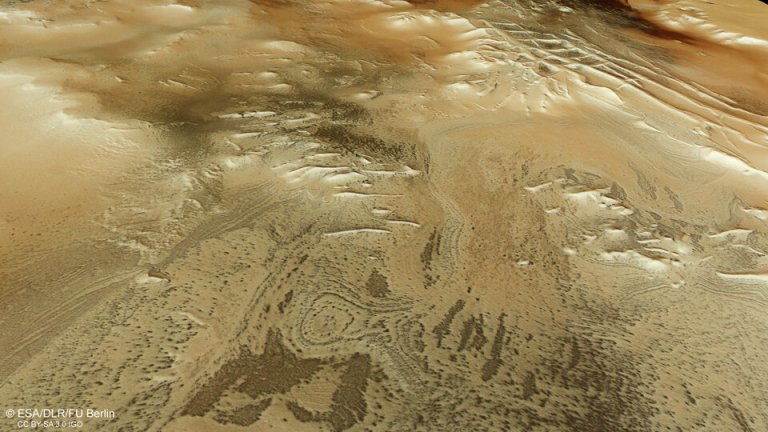
view of the Inca city on Mars
This new view of the Inca city and its hidden “arachn-like inhabitants” was captured by the Mars Express high-resolution stereo camera. We still don’t know exactly how the Inca City was formed. Perhaps the sand dunes turned to stone over time. It’s possible that materials such as magma or sand seep through fractured sheets of Martian rock. Or the ridges may be “eskers,” sinuous structures associated with glaciers.
The “walls” of the Inca city are part of a large circle with a diameter of 86 km. Therefore, scientists suspect that the “city” is located inside a large crater, which itself was formed as a result of a rock falling from space onto the surface of the planet. This impact likely caused fissures to appear in the surrounding plain, which were then filled by rising lava and have since been worn away over time.
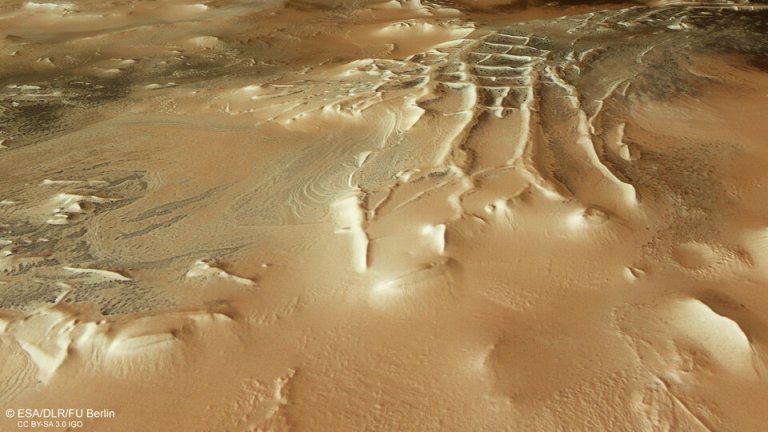
view of the Inca city on Mars
Toward the middle part of the image, the landscape changes somewhat: large round and oval curls appear, creating a marble effect. This effect is thought to occur when layered deposits wear away over time.
To the right of the center of the frame are several prominent mounds with steep slopes and flat tops that rise more than 1500 m above the surrounding area. They form when softer material is eroded over time by wind, water or ice, leaving behind harder material from which these hills are formed. The ground is increasingly covered with smooth light dust. Some traces of “spiders” can be seen here, scattered across the plateau, hiding among various canyons and depressions.
Methane in Gale Crater behaves in unexpected ways
Living things produce most of the methane on Earth. But scientists haven’t found convincing signs of modern or ancient life on Mars, and so they didn’t expect to find methane there. However, the portable chemistry laboratory aboard Curiosity, known as SAM, or Sample Analysis on Mars, has consistently detected traces of the gas near the surface of Gale Crater, the only place on the surface of Mars where methane has been detected so far. Its likely source, scientists suggest, is geological mechanisms involving water and rocks deep underground.
If that were the whole story, it would be easy. However, SAM found that methane in Gale Crater behaves in unexpected ways. It appears at night and disappears during the day. It fluctuates depending on the season and sometimes reaches levels 40 times higher than normal. Surprisingly, methane also does not accumulate in the atmosphere: the ESA (European Space Agency) ExoMars Trace Gas Orbiter, sent to Mars specifically to study gas in the atmosphere, did not detect methane.
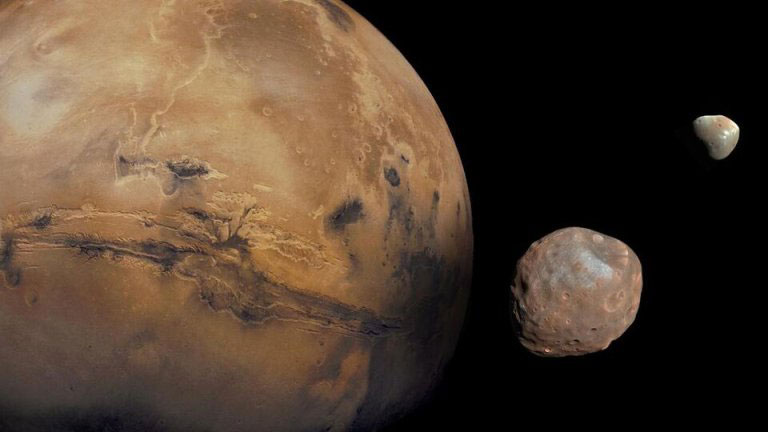
Moons of Mars
Why do some scientific instruments detect methane on the Red Planet and others do not? Methane is keeping Mars scientists busy with lab work and computer modeling projects that aim to explain why the gas behaves strangely and is only found in Gale Crater. A NASA research team recently shared an interesting proposal.
In a March paper in the Journal of Geophysical Research: Planets, the team suggested that methane – no matter how it is produced – could be sealed beneath solidified salt that could form in Martian regolith, which is a “soil” made up of broken rock and dust. When temperatures rise during warmer months or during warmer times of day, weakening the seal, methane can leak out.
Researchers led by Alexander Pavlov, a planetary scientist at NASA’s Goddard Space Flight Center in Greenbelt, Maryland, speculate that the gas could also spew out in puffs when seals crack under the pressure of, say, a rover the size of a small SUV driving over it. The team’s hypothesis may help explain why methane is only detected in Gale Crater, Pavlov said, given that it is one of two places on Mars where the robot roams and drills into the surface. (Another robot is exploring Jezero Crater, NASA’s Perseverance rover, although that rover does not have a methane-detecting instrument.)
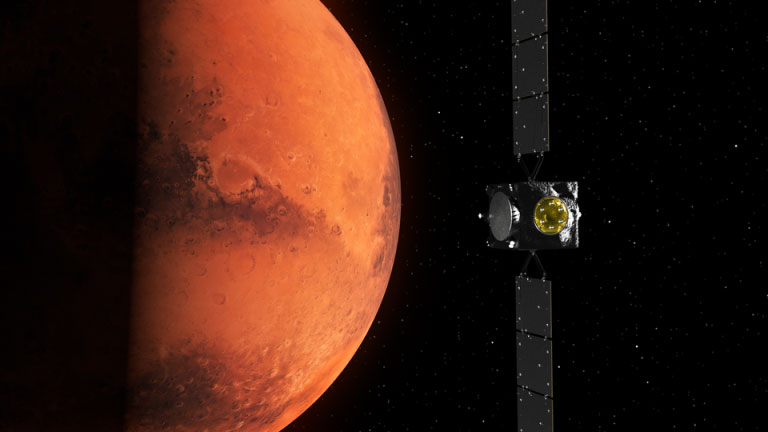
Hera near Mars
Pavlov traces the origins of this hypothesis to an unrelated experiment he conducted in 2017, which involved growing microorganisms in artificial Martian permafrost (frozen soil) filled with salt, like much of Martian permafrost. Pavlov and his colleagues tested whether bacteria known as halophiles, which live in salt lakes and other salt-rich environments on Earth, could thrive in similar conditions on Mars.
The results of growing the microbes were inconclusive, he said, but the researchers noticed something unexpected: the top layer of soil formed a crust of salt when the salty ice sublimated from a solid to a gas, leaving behind salt.
“We didn’t think much about it at the time,” Pavlov said, but he remembered the soil crust in 2019, when SAM’s tunable laser spectrometer detected a methane burst that no one could explain. That’s when he and his team began testing the conditions under which hardened salt seals could form and crack.
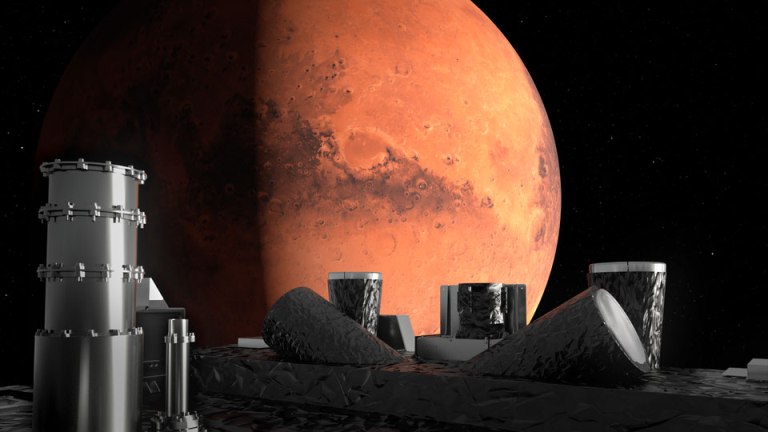
Mars, as seen from the top “asteroid deck” of Hera
Pavlov’s team tested five permafrost samples filled with varying concentrations of a salt called perchlorate, which is widespread on Mars. There is probably no permafrost in Gale Crater today, but compactions may have formed long ago when Gale was colder and icier. The scientists exposed each sample to varying temperatures and air pressure in the Mars Simulation Chamber at NASA Goddard.
Periodically, Pavlov’s team injected neon, an analogue of methane, under a soil sample and measured the pressure of the gas below and above it. Higher pressure under the sample meant that the gas was trapped. The seal ultimately formed under Martian conditions within 3–13 days only in samples with perchlorate concentrations between 5% and 10%.
This is a much higher concentration of salt than Curiosity measured in Gale Crater. But the regolith there is rich in another type of salt minerals, called sulfates, which Pavlov’s team wants to next test to see if they can also form seals.
The Curiosity rover arrived in a region believed to have formed as a result of the drying out climate of Mars. Improving our understanding of methane formation and destruction processes on Mars is a key recommendation of NASA’s 2022 Planetary Mission Senior Review, and theoretical work like Pavlov’s is critical to this effort. But scientists say they also need more consistent methane measurements.

Deimos in high resolution
SAM detects methane only a few times a year, because the rest of the time it is busy with its main job – drilling samples from the surface and analyzing their chemical composition.
“Methane experiments are resource-intensive, so we have to be very strategic when we decide to do them,” said Goddard’s Charles Malespin, SAM’s principal investigator.
However, testing how often spikes in methane levels occur will require a new generation of ground-based instruments that continuously measure methane levels at many locations across Mars, scientists say.
“Some of the work on methane will have to be left to future ground-based spacecraft, which will be more focused on answering these specific questions,” Vasavada said.
Canyons and clouds on Mars
Mars Express arrived at Mars in late 2003 and completed its 25,000th orbit on October 19, 2023. In the two decades since its arrival, the orbiter has completely changed our understanding of the planet. It mapped the atmosphere more completely than ever before, traced the history of water on the surface of Mars, studied two small Martian moons in unprecedented detail, and provided breathtaking views of the planet in three dimensions.
This new look is no exception. The focus is on the Tharsis region, which covers about a quarter of the planet’s surface and is home to Mars’ famous colossal volcanoes. Here you can see many volcanoes: Olympus, Arsia, Pavonis and Askrey Mons, as well as Jovis, Byblis and Ulysses Tolus. Mount Olympus is the largest, reaching a height of almost 22 km (compared to Mount Everest, which is 8.8 km high here on Earth).
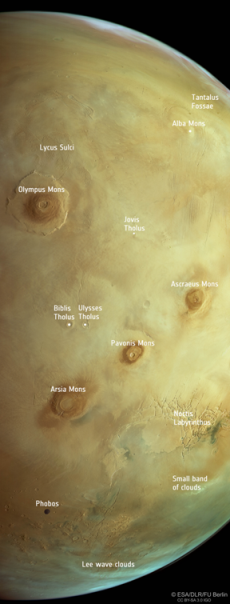
As fascinating as they are, the volcanoes of Mars are far from the only interesting feature to be seen here. Interestingly, Mars Express also captured a surprise visitor to Mars’ largest moon, Phobos, which can be seen as a dark blob passing in the lower left corner. By solar system standards, Phobos is located very close to Mars, orbiting only 6,000 km from the surface of Mars. For comparison, our own Moon is approximately 385,000 km from the Earth’s surface.
The jagged, cracked canyons of Noctis’s Labyrinth, previously seen several times by Mars Express, including during a rendered flyby, can also be seen beneath the three volcanoes that dissect the frame. The large Lycus Sulci landslide can be seen to the north of Mount Olympus, as well as the Tantalus Pit depressions and valleys in the upper right. These features have previously been studied by Mars Express.
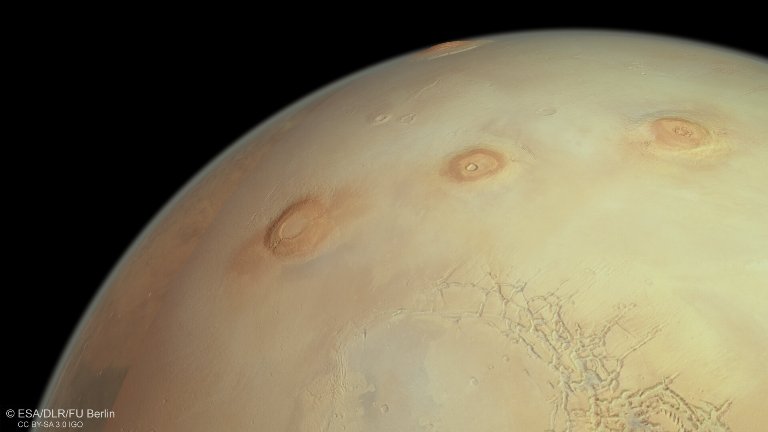
Some interesting weather features can be seen at the bottom of the frame, where a blue tint permeates this sand-colored scene. The colorful streaks are the clouds: a small bright band of clouds on the right and wavering “leeward wave” clouds on the left. Lee wave clouds occur when air currents flow around an obstacle in the terrain below, such as a hill, and gain an increase in speed. The air then forms a wave-like structure on the sheltered (leeward) side of the ridge.
A group of European scientists has published the most detailed geological map of Oxia Planum
A team of European scientists has published the most detailed geological map yet of Oxia Planum, the landing site of ESA’s Rosalind Franklin rover on Mars. This close look at the geography and geological history of the area will help the rover explore the once water-rich terrain for signs of past and present life.
The map gives scientists a head start before Rosalind Franklin lands there in 2030. Over four years of work, the map has identified 15 features with distinctive geological features that could help decide how the rover explores the area, interprets its surroundings and attempts to collect evidence. primitive life.
Oxia Planum is located near the Martian equator and contains sedimentary deposits that are nearly four billion years old. On a geological scale, this will be the oldest landing site visited by a rover. The region is rich in clay minerals formed in the presence of water. These stones are ideal for preserving evidence of the earliest forms of life. This makes it a great place to look for clues about whether life once existed on the Red Planet.
Rosalind Franklin Mars rover mission
During the COVID shutdown, Rosalind Franklin’s research team began an online training program for about 80 volunteers to map their chosen landing site. The work was divided into 134 one-square-kilometer sections to allow the team to fully cover the proposed landing zone. The scientists used a web-based system that allowed everyone to work on the map in parallel. The software was provided by NASA’s Jet Propulsion Laboratory and installed at ESA.
The data came from the Color and Stereo Surface Imaging System (CaSSIS) on board the ExoMars Trace Gas Orbiter and several instruments on NASA’s Mars Reconnaissance Orbiter (MRO), including the HiRISE camera, which returns images from Mars orbit at 25 cm per pixel resolution.
Mapping managers then pulled together information from all the areas to form a coherent map that shows the geology of the landing site in unprecedented detail. The map includes major bedrock types, as well as various shaped structures such as ridges and craters. It even contains material that lies on top, such as blown by the wind or thrown long distances when meteorites hit the surface.
The result is the highest-resolution map of Oxia Planum, created at a scale of 1:25,000, according to which each centimeter equals 250 meters on the Martian surface. Rosalind Franklin’s average run of 25 to 50 meters per day would be one to two millimeters on the map.
The map was published in the Journal of Maps along with a scientific paper that includes observations and interpretations of each geological unit, and will soon be followed by a second publication exploring what these geological units mean for scientists’ ideas about what the environment of ancient Mars was like.
Geological map of Oxia Planum
During the exercise, scientists from different groups became familiar with the geology and geography of the landing site several years before the rover began operating on Mars. Rosalind Franklin’s science team now has a better idea of potential science sites, the type of terrain the rover will encounter, and some of the dangers along its path.
ESA’s Rosalind Franklin rover is equipped to search for evidence of past and present life on Mars through its drilling and science instruments. This will allow science teams on Earth to plan strategy for Rosalind Franklin’s daily expeditions to Mars as they determine the best location to drill in the harsh radiation environment and daily variations in surface temperature.
Rosalind Franklin will be the first rover to drill two meters below the surface, collecting samples where biosignatures are more likely to persist than on the surface and analyzing them in its onboard laboratory.
Magnetic field of Mars and solar radiation
The Sun enters a period of peak activity called solar maximum, which occurs approximately every 11 years. During solar maximum, the Sun is especially prone to throwing fire “tantrums” in various forms, including solar flares and coronal mass ejections, which fire radiation deep into space. When a series of such solar events occurs, it is called a solar storm.
The Earth’s magnetic field largely protects our home planet from the effects of these storms. But Mars has long lost its global magnetic field, leaving the Red Planet more vulnerable to energetic particles from the Sun. How intense is solar activity on Mars? Researchers hope the current solar maximum will give them a chance to find out. Before sending people there, space agencies need to determine, among many other details, what radiation protection the astronauts will need.

This coronal mass ejection, recorded by NASA’s Solar Dynamics Observatory, erupted on the Sun on August 31, 2012, traveling at more than 900 miles per second and sending radiation deep into space. Earth’s magnetic field protects it from radiation caused by solar events such as this, while Mars lacks such protection. NASA/GFSC/SDO
“For people and objects on the surface of Mars, we don’t have a clear idea of what the effect of radiation is during solar activity,” said Shannon Curry of the Laboratory for Atmospheric and Space Physics at the University of Colorado Boulder. Curry is the principal investigator of NASA’s MAVEN (Martian Atmosphere and Unstable Evolution) orbiter, managed by NASA Goddard Space Flight Center in Greenbelt, Maryland. “I’d actually really like to see a ‘big event’ on Mars this year—a big event that we can study to better understand solar radiation before astronauts go to Mars.”
MAVEN observes radiation, solar particles and more from above Mars. A planet’s thin atmosphere can affect the intensity of particles by the time they reach the surface, which is where NASA’s Curiosity rover comes in. Data from Curiosity’s Radiation Assessment Detector, or RAD, has helped scientists understand how radiation destroys carbon-based molecules. on the surface, a process that could influence whether signs of ancient microbial life remain there. The instrument also gave NASA an idea of what kind of radiation protection astronauts could expect when using caves, lava tubes or rocks for protection. When a solar event occurs, scientists look at both the number of solar particles and their energy.
NASA’s MAVEN and the agency’s Curiosity rover will study solar flares and radiation on Mars during solar maximum, the period when the Sun is at its most active. NASA/JPL-Caltech/GSFC/SDO/MSSS/University of Colorado
“You could have a million low-energy particles or 10 extremely high-energy particles,” said RAD principal investigator Don Hassler of the Southwest Research Institute office in Boulder, Colorado. “Although the MAVEN instruments are more sensitive to lower-energy instruments, RAD is the only instrument capable of seeing high-energy instruments passing through the atmosphere to the surface where astronauts might be.”
When MAVEN detects a large solar flare, the orbiter team reports it to the Curiosity team so they can monitor changes in the RAD data. Both missions could even collect time series that measure changes down to half a second as particles reach the Martian atmosphere, interact with it, and ultimately hit the surface.
The MAVEN mission also spearheads an early warning system that lets other spacecraft teams on Mars know when radiation levels are starting to rise. The warning allows missions to turn off instruments that may be vulnerable to solar flares and could interfere with electronics and radio communications.
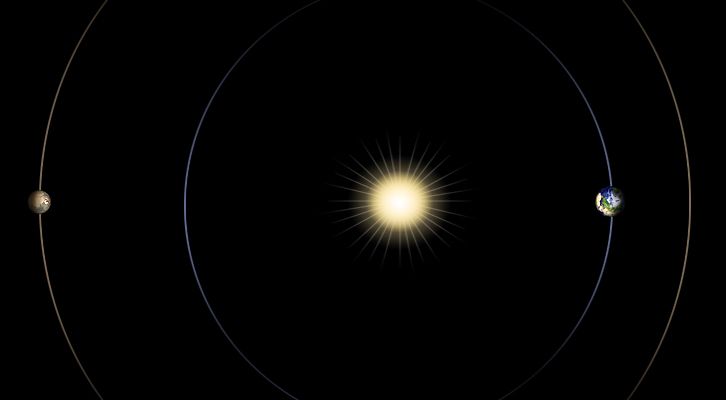
In addition to helping keep astronauts and spacecraft safe, studying solar maximum may also help understand why Mars transformed from a warm, wet Earth-like world billions of years ago into the icy desert it is today. The planet is at the point in its orbit when it is closest to the Sun, which heats the atmosphere. This can cause billowing dust storms to cover the surface. Sometimes storms merge and become global.
Although there is little water left on Mars (mostly ice under the surface and at the poles), some of it still circulates in the atmosphere as vapor. Scientists wonder whether global dust storms help release this water vapor, lifting it high above the planet, where the atmosphere is destroyed during solar storms. One theory is that this process, repeated enough times over thousands of years, could explain how Mars today has virtually no lakes or rivers and virtually no water left.
If a global dust storm occurred at the same time as a solar storm, it would provide an opportunity to test this theory. Scientists are especially excited that this particular solar maximum occurs at the beginning of the dustiest season on Mars, but they also know that a global dust storm is a rare event.
Why NASA periodically suspends missions to Mars
About every two years, Earth and Mars experience a short period known as a solar conjunction, when the two planets find themselves on opposite sides of the Sun. On average, Mars is usually about 140 million miles away, but this increases during a solar conjunction. This distance is about 235 million miles—about 2.5 astronomical units (AU) from Earth. It’s essentially a cosmic reversal of the Martian opposition, with Earth sandwiched between Mars and the Sun (and God of War’s planet looking especially bloodthirsty in the night sky).
The sun is a giant ball of interference. When Mars rovers and orbiters try to send data back to Earth, the information can be disrupted by charged particles from the Sun, which can leave gaps in the data. But the reverse scenario is more catastrophic, as confusing commands sent by NASA could lead to mission failure.
NASA is looking for a new way to bring precious samples from Mars back to Earth
These samples are being collected by the Perseverance rover at Jezero Crater on Mars, where a lake and river delta were located billions of years ago. Obtaining samples is one of NASA’s main scientific goals. Studying pristine material from the Red Planet in well-equipped laboratories around the world could yield key information about Mars, including perhaps whether it ever supported life, NASA officials say.
The agency has been using a Mars Sample Return (MSR) architecture for some time, but repeated delays and cost overruns have made the original plan impractical, NASA officials said April 15.
“The bottom line is that $11 billion is too expensive, and not returning samples until 2040 is unacceptably too long,” NASA Administrator Bill Nelson said on a call with reporters this afternoon.
That price is the top estimate calculated by an independent expert panel that published its findings last September. For perspective, a July 2020 study estimated the total cost of MSR to be between $2.5 billion and $3 billion.
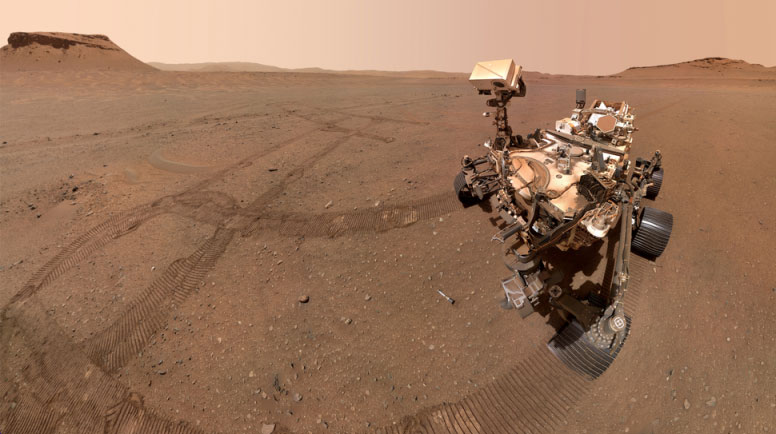
NASA’s Perseverance rover took this selfie while looking at one of the 10 sample tubes stored in the sample repository it created in an area called the Three Forks. This image was captured by the WATSON camera on the rover’s robotic arm on January 20, 2023, the 684th Martian day, or sol, of the mission. NASA/JPL-Caltech/MSSS
The NASA team analyzed the September results and determined that the agency would not be able to deliver Perseverance samples to Earth until 2040 with the architecture in place. This conclusion cited reasons such as current budget constraints and a desire not to destroy other high-priority science efforts, such as the Dragonfly drone mission to Saturn’s huge moon Titan.
By the way, the current architecture would make it possible to send a landing module built by NASA to the Jezero crater. This lander would have brought with it a rocket called the Mars Ascent Vehicle (MAV) and possibly several small recovery helicopters similar to NASA’s pioneering rotorcraft Ingenuity.
The idea was for Perseverance to deliver its samples to the lander and then load them into the MAV. Helicopters may have also performed some of this loading work, especially if Perseverance was not in the best shape when the lander arrived. The MAV would then send the samples into Mars orbit, where a spacecraft built by the European Space Agency would catch the container and fly it back to Earth.
But NASA is now looking for a new path, trying to cut costs and get samples here sooner. Saving money will help the agency’s other science projects, and speeding up timelines could help the agency plan crewed missions to Mars. NASA is also eyeing private industry, with the agency planning to issue a call for new ideas from the commercial sector.




